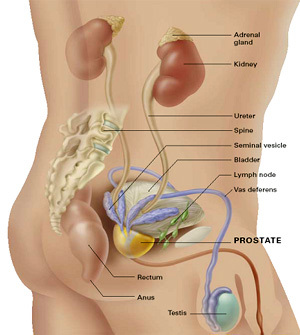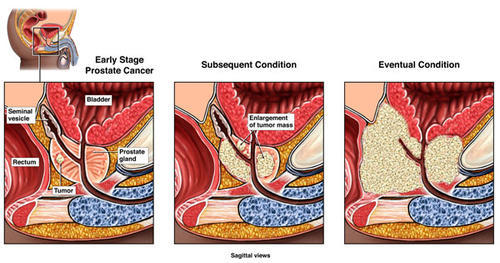| Treatments, Symptoms and Detection Prostate cancer is one of the most common types of cancer among men but there are several misconceptions about the disease. The prostate is a small gland, about the size of a walnut in younger men, located at the base of the urinary bladder. The urethra is practically surrounded by the prostate gland and part of the function of the prostate is to aid in urination control. The prostate tends to grow larger with age, a condition known as benign prostatic hyperplasia (BPH). This enlargement can cause symptoms similar to those of prostate cancer, often leading to unfounded fears among men who experience frequent need to urinate or other urinary problems. Prostate cancer is a tumour formed from malignant cells in the prostate, often stimulated by testosterone. Normally, the tumour grows very slowly and is confined to just the prostate and the sufferer is often unaware of the disease, but in some cases the growth rate can increase, causing the cancer to spread outside the prostate to other parts of the body such as the liver and lungs. Prostate cancer is more prevalent among men older than 40, so doctors recommend that screening tests be carried out at regular intervals for those aged 40 or more. |  |
 | There are basically two types of screening tests, a digital rectal examination to check for enlargement or abnormalities in the prostate, or a blood test known as prostate specific antigen (PSA), which checks for raised levels of a specific protein in the blood stream. Neither method is conclusive, but is used to indicate whether further tests are warranted. A true result is obtained through biopsy of small samples taken from the prostate, from which a pathologist can make an assessment of the type of cancer, if any, and produce a grading known as the Gleason's score. A score of 6 indicates a low grade disease while 8 to 10 indicates a more aggressive disease. Treatment of prostate cancer can take a number of forms. If the cancer is localised to the prostate gland, then surgery, hormonal therapy, radiation therapy or, in some cases, cryotherapy are used. A new technique involving ultrasound is also under investigation, but this has yet to be approved. |
| Prevention is better than cure, so the saying goes, but the jury is still out on methods to prevent prostate cancer. Some researchers have suggested that low-fat diets or diets containing soybean products can prevent prostate cancer. At present, the best weapon is early detection through screening tests. Rest assured, a diagnosis of prostate cancer is not a death sentence. Many men can and do live with prostate cancer without experiencing health problems. But if you're over 40, get that screening test done! | |